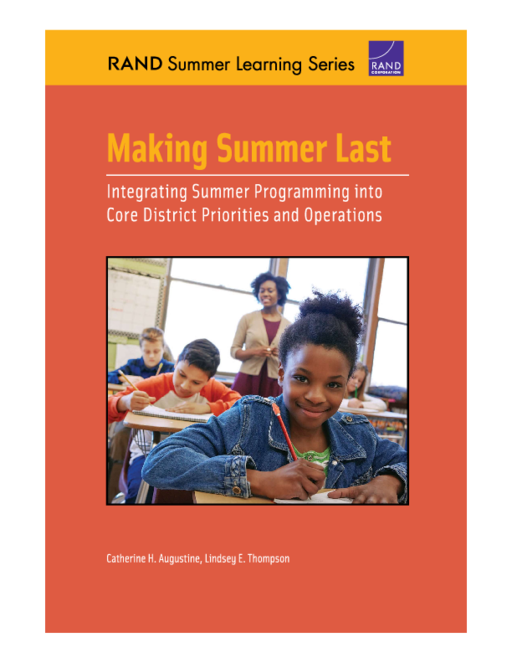
Breadcrumb
- Wallace
- Reports
- Making Summer Last Integrating S...
Making Summer Last
Integrating Summer Programming into Core District Priorities and Operations

- Author(s)
- Catherine H. Augustine and Lindsey E. Thompson
- Publisher(s)
- RAND Corporation
- DOI Link
- https://doi.org/10.7249/RR2038
Summary
How we did this
Data for this report are drawn from interviews, meeting minutes, and summer program and district documents. Researchers interviewed more than 60 district staff members involved in summer programming in three school districts—Dallas, Pittsburgh, and Rochester—from November 2015 through January 2016.
Districts can take steps to integrate their summer programs into their schools’ core priorities. Doing this can help to ensure the long-term sustainability of their programs.
Those are the conclusions of this report, which examines how three school districts—Dallas, Pittsburgh and Rochester—went about institutionalizing their summer learning programs.
While the districts’ aim was to make sure their programs had staying power, they also sought to increase program quality and efficiency. That involved, among other things:
- Guaranteeing widespread buy-in
- Routinized implementation
- Recurring allocations of money and time.
Program leaders say their efforts helped garner active support for their programs. They also resulted in improvements and efficiencies.
The districts were part of a Wallace Foundation project to create more summer learning opportunities for low-income students. The project also sought to find out how voluntary-attendance summer learning programs can help such students succeed in school.
Strategies and challenges
The programs’ leaders used three main strategies to try to ensure the durability of their efforts:
- Building awareness of their programs and connecting program goals to larger district goals
- Ensuring all relevant departments took part in the planning process
- Involving expert staff members and existing district systems in supporting the programs.
All three strategies met with many challenges. Some school and district staff members viewed summer programming as competing with other priorities. Others reserved judgment until they could see evidence of improved student outcomes. In two districts, an inclusive planning process led to disagreements over who had decision-making authority. Expert staff members also needed more time, the right incentives, and greater understanding of summer programming to provide effective support.
All three districts continued to fund their programs at the same level through summer 2017, when Wallace funding was scheduled to end.

Summer learning programs can potentially mitigate the gaps between students from low-income and higher-income households.
Key Takeaways
- Programs used three main strategies to try to ensure the durability of their efforts.
- Program leaders can cultivate buy-in by helping district and school staff understand what it’s like to attend a summer program.
- While building cross-departmental planning teams is often challenging, they lead to smoother-running programs in the long-run.
- Building awareness can include asking teachers and principals to take on such roles as recruiting students for summer programs.








